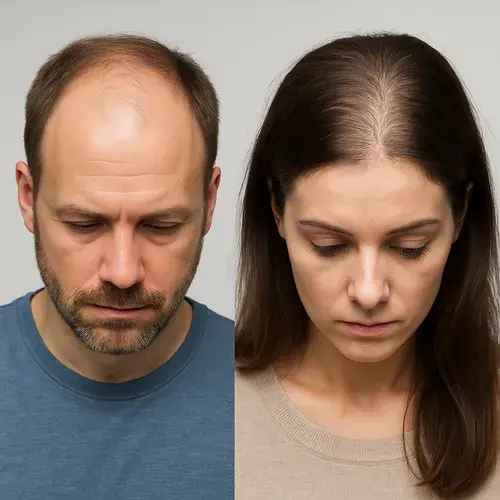Is Hair Loss Only a Male Problem? Exploring Hair Loss in Women and Men
Hair loss affects over 85% of men and 55% of women, with androgenetic alopecia as the most common form. Hormones, genetics, and psychosocial impacts shape this widespread condition.

Hair loss is a common issue that affects both men and women, often leading to significant psychosocial impacts. While it is true that hair loss is more prevalent in men, it is by no means exclusive to them. In this article, we will delve into the different forms of hair loss experienced by both genders, exploring the causes, symptoms, and statistics surrounding this widespread condition. The Prevalence of Hair Loss Hair loss is a universal experience that transcends gender boundaries. According to statistics, more than 55% of women and 85% of men are likely to experience some form of hair loss in their lifetime . By age 50, up to 40% of women will have noticeable hair loss, while by age 65, an estimated 53% of men and 37% of women will experience baldness . These numbers underscore the widespread nature of hair loss and highlight the need for understanding its various forms. Androgenetic Alopecia: The Most Common Form Androgenetic alopecia (AGA), also known as male and female pattern baldness, is the most common form of hair loss in both men and women. In men, AGA typically affects the central scalp, including the midfrontal, temporal, and vertex regions. This condition progresses slowly over years, resulting in thinning of hair and nonscarring loss of terminal hairs . The 7-stage Hamilton-Norwood scale is commonly used to classify male pattern hair loss, while the 3-grade Ludwig scale is used for female pattern hair loss . Female Pattern Hair Loss Female pattern hair loss presents differently from its male counterpart. It often involves diffuse thinning across the central scalp and can also manifest as a "Christmas tree" pattern along the midline part of the hair due to prominent hair thinning towards the front of the scalp with minimal involvement of the hairline . Unlike men, women's frontal hairlines are less likely to be involved in hair loss, but bitemporal thinning is common. Hormonal Influences Hormonal changes play a significant role in both male and female pattern hair loss. In men, androgens such as dihydrotestosterone (DHT) contribute to hair follicle shrinkage and eventual loss. In women, the role of circulating estrogens is less clear, with conflicting evidence regarding whether estrogen stimulates or inhibits the hair follicle . The prevalence of hair loss increases after menopause, suggesting that hormonal fluctuations may be a contributing factor. Genetic Factors Genetic factors significantly influence hair loss in both men and women. While conventional wisdom historically suggested that men inherit pattern baldness from their mother's side, new research indicates a more complex genetic picture . The genetic descent also influences the prevalence of AGA, with it being most common among people whose heritage is Caucasian, followed by Asian, African, Native American, and Eskimo . Psychosocial Impacts Hair loss has significant psychosocial effects on both men and women. Stress and diminished self-esteem are common among individuals experiencing hair loss. The impact can be particularly pronounced for women due to societal beauty standards and the expectation of maintaining a full head of hair . Conclusion Hair loss is not exclusively a male problem; it affects a significant portion of the female population as well. Understanding the different forms of hair loss—such as androgenetic alopecia—and their causes can help individuals address this issue more effectively. By recognizing the universal nature of hair loss and its impact on both genders, we can work towards reducing the stigma associated with it and providing better support for those affected.
Need Professional Consultation?
Our professional doctors will provide detailed hair and scalp analysis and develop personalized treatment plans.
Book Consultation Now